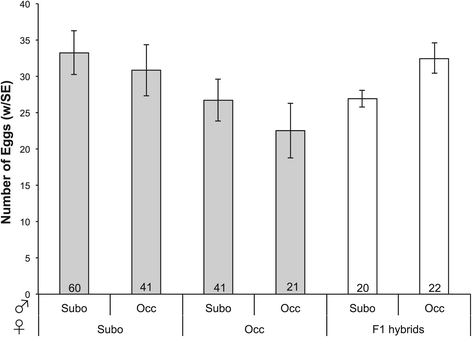Asymmetrical sexual isolation but no postmating isolation between the closely related species Drosophila suboccidentalis and Drosophila occidentalis
- PMID: 25881167
- PMCID: PMC4369358
- DOI: 10.1186/s12862-015-0328-y
Asymmetrical sexual isolation but no postmating isolation between the closely related species Drosophila suboccidentalis and Drosophila occidentalis
Abstract
Background: During the speciation process several types of isolating barriers can arise that limit gene flow between diverging populations. Studying recently isolated species can inform our understanding of how and when these barriers arise, and which barriers may be most important to limiting gene flow. Here we focus on Drosophila suboccidentalis and D. occidentalis, which are closely related mushroom-feeding species that inhabit western North America and are not known to overlap in geographic range. We investigate patterns of reproductive isolation between these species, including premating, postmating prezygotic, and postzygotic barriers to gene flow.
Results: Using flies that originate from a single population of each species, we find that the strength of premating sexual isolation between these species is asymmetric: while D. occidentalis females mate with D. suboccidentalis males at a reduced but moderate rate, D. suboccidentalis females discriminate strongly against mating with D. occidentalis males. Female hybrids will mate at high rates with males of either species, indicating that this discrimination has a recessive genetic basis. Hybrid males are accepted by females of both species. We do not find evidence for postmating prezygotic or postzygotic isolating barriers, as females use the sperm of heterospecific males and both male and female hybrids are fully fertile.
Conclusions: Premating isolation is substantial but incomplete, and appears to be the primary form of reproductive isolation between these species. If these species do hybridize, the lack of postzygotic barriers may allow for gene flow between them. Given that these species are recently diverged and are not known to be sympatric, the level of premating isolation is relatively strong given the lack of intrinsic postzygotic isolation. Further work is necessary to characterize the geographic and genetic variation in reproductive isolating barriers, as well as to determine the factors that drive reproductive isolation and the consequences that isolating barriers as well as geographic isolation have had on patterns of gene flow between these species.
Figures





References
-
- Coyne JA, Orr HA. Speciation, vol. 37. Sunderland, MA: Sinauer Associates; 2004.
-
- Mayr E. Animal species and evolution. Cambridge: Harvard University Press; 1963.
Publication types
MeSH terms
Grants and funding
LinkOut - more resources
Full Text Sources
Other Literature Sources
Molecular Biology Databases

